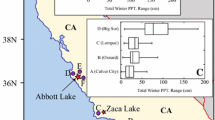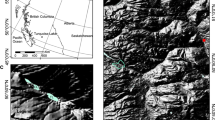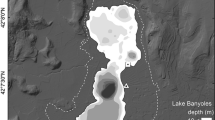Abstract
Reservoir 14C age offsets track past changes in atmospheric carbon content, air–water gas exchange, and freshwater circulation in water bodies. Determination of a freshwater reservoir correction (FWRC) is a crucial step in age-model development to provide accurate climate-proxy records. We employ published, recent water column 14C measurements from Lake Superior, and reassess unpublished and published 14C measurements of live-collected, pre-bomb bivalve shells dated from lakes Michigan, Huron, Erie, and Ontario, to provide the most comprehensive, consistent snapshot of the mid twentieth century (pre-bomb) FWRC for the Laurentian Great Lakes assembled to date. We also use mollusk/ostracod and wood shell ages from the bottom 60 cm of a 1218 cm core from Lake Erie’s eastern basin to estimate a late Holocene FWRC. The FWRC for all live-collected samples were recalculated in a consistent-manner using the IntCal20 atmospheric 14C curve. The revised corrections provide modest revisions (± 10%) of published values. The revised FWRC values document a generally increasing trend along the circulation pathway from Lake Superior to Michigan, Huron, and Erie with average FWRC in 14C years of 206 ± 55 for Lake Superior, 247 ± 81 for Lake Michigan, 365 ± 41 in Green Bay, 340 ± 72 for northern Lake Huron, 321 ± 71 in Georgian Bay, to 443 ± 62 in southern Lake Huron. For Lake Erie, the average FWRC for the western basin is 455 ± 52 14C years, for the central basin 676 ± 52 14C years, and 748 ± 76 14C years for the eastern basin. In Lake Ontario, the average FWRC for the western part of the lake is 540 ± 55 14C years, smaller than the value observed for Lake Erie. The late Holocene FWRC for eastern Lake Erie is estimated between 440 ± 124 14C years and 306 ± 124 14C years, which is smaller than the pre-bomb value. This study provides a conceptual framework and statistical model to explain the observed pattern of FWRC in the Great Lakes. Higher FWRC values are encountered in basins surrounded by more carbonate bedrock and higher inflow rates, mostly from upstream lakes. On a basin-wide scale, there is a statistically significant positive linear relation for the observed FWRC, which depends on the fractional area of carbonate bedrock within each Great Lake watershed and the inflow rate to each basin, accounting for essentially all the variance in the data.









Similar content being viewed by others
References
Alves E, Macario K, Ascough P, Bronk Ramsey C (2018) The worldwide marine radiocarbon reservoir effect: definitions, mechanisms, and prospects. Rev Geophys 56:278–305. https://doi.org/10.1002/2017RG000588
Alves E, Macario K, Urrutia F, Cardoso R, Bronk Ramsey C (2019) Accounting for the marine reservoir effect in radiocarbon calibration. Quat Sci Rev 209:129–138
Alves E, Macario K, Spotorno P, Oliveira F, Muniz M, Fallon S, Souza R, Salvador A, Eschner A, Bronk Ramsey C (2021) Nineteenth-century expeditions and the radiocarbon marine reservoir effect on the Brazilian coast. Geochim Cosmochim Acta 297:276–287
Ascough PL, Cook GT, Hastie H, Dunbar E, Church MJ, Einarsson A, McGovern TH, Dugmore AJ (2011) An Icelandic freshwater radiocarbon reservoir effect: Implications for lacustrine 14C chronologies. Holocene 21:1073–1080. https://doi.org/10.1177/0959683611400466
Anderson TW, Lewis CFM (2012) A new water-level history for Lake Ontario basin: evidence for a climate-driven early Holocene lowstand. J Paleolim 47:513–530. https://doi.org/10.1007/s10933-011-9551-8
Benson L (1993) Factors affecting 14C ages of lacustrine carbonates: timing of the last highstand in the Lahontan Basin. Quat Res 39:163–174
Blaauw M (2010) Methods and code for “classical” age-modelling of radiocarbon sequences. Quat Geochronol 5:512–518. https://doi.org/10.1016/j.quageo.2010.01.002
Blaauw M, Christen JA (2011) Flexible paleoclimate age-depth models using an autoregressive gamma process. Bayes Anal 6:457–474. https://doi.org/10.1214/11-BA618
Bolsenga SJ, Herdendorf CE (1993) Lake Erie and Lake St. Clair Handbook. Great Lakes Books, Wayne State University Press
Broecker W, Walton A (1959) The geochemistry of 14C in freshwater systems. Geochim Cosmochim Acta 16:15–38
Butzin M, Heaton T, Kohler P, Lohmann G (2020) A short note on marine reservoir age simulations used in IntCal20. Radiocarbon 62:865–871
Chasar LS, Chanton JP, Glaser PH, Siegel DI, Rivers JS (2000) Radiocarbon and stable carbon isotopic evidence for transport and transformation of dissolved organic carbon, dissolved, inorganic carbon, and CH4 in a northern Minnesota peatland. Global Biogeochem Cycles 14:1095–1108
Clotts RA, McCambridge CE, Barrera E, Saylor BZ, Palmer DF, Coakley JP (2005) Middle Holocene hydrologic change and hypolimnion formation in Lake Erie. J Gt Lakes Res 31:296–308. https://doi.org/10.1016/S0380-1330(05)70322-1
Croley TE, Lewis CF (2006) Warmer and drier climates that make terminal Great Lakes. J Gt Lakes Res 32:852–869
Culleton BJ (2006) Implications of a freshwater radiocarbon reservoir correction for the timing of late Holocene settlement of the Elk Hills, Kern County, California. J Archaeol Sci 33:1331–1339. https://doi.org/10.1016/j.jas.2006.01.013
Doran PT, Berger GW, Lyons WB, Wharton Jr RA, Davisson ML, Southon J, Dibb JE, Dating (1999) Quaternary lacustrine sediments in the McMurdo Dry Valleys, Antarctica. Palaeogeogr Palaeoclimatol Palaeoecol 147:223–239
Dury JPR, Eriksson G, Savinetsky A, Dobrovolskaya M, Dneprovsky K, Harris AJT, van der Pilcht J, Jordon P, Liden K (2021) Species-specific reservoir effect estimates: a case study of archaeological marine samples from the Bering Strait. Holocene 32:1209–1221. https://doi.org/10.1177/09596836211041728
Geyh MA, Schotterer U, Grosjean M (1997) Temporal changes of the 14C reservoir effect in lakes. Radiocarbon 40:921–931. https://doi.org/10.1017/s0033822200018890
Godwin FRS (1962) Radiocarbon dating—Fifth international conference. Nature 195:943–945
Grannemann NG, Hunt RJ, Nicholas JR, Reilly TE, Winter TC (2000) The importance of ground water in the Great Lakes Region: USGS Water Resources Investigations Report 00-4008
Hua Q, Barbetti M, Rakowski AZ (2013) Atmospheric radiocarbon for the period 1950–2010. Radiocarbon 55:2059–2072. https://doi.org/10.2458/azu_js_rc.v55i2.16177
Hujdas I, Hua Q (2021) Bomb 14C—A tracer and time marker of the mid-20th century. Climate of the Past Blog https://blogs.egu.eu/divisions/cl/2021/07/14/bomb-14c-a-tracer-and-time-marker-of-the-mid-20th-century/
Jull AJT, Burr GS, Hodgins GWL (2013) Radiocarbon dating, reservoir effects, and calibration. Quat Int 299:64–71. https://doi.org/10.1016/j.quaint.2012.10.028
Kempthorne RA (2000) Geochemical and lithological records of the hypsithermal and Nipissing flood events from Lake Erie. MSc thesis, University of Akron
Larsen CE (1985) Lake level, uplift, and outlet incision, the Nipissing and Algoma Great Lakes. In: Karrow PF, Calkin PPE (eds) Quaternary Evolution of the Great Lakes, Geological Association of Canada Spec Paper 30:63–77
Lewis CFM, Cameron GDM, Anderson TW, Heil CW Jr, Gareau PL (2012) Lake levels in the Erie Basin of the Laurentian Great Lakes. J Paleolimnol 47:493–511. https://doi.org/10.1007/s10933-012-9578-5
Lewis CFM, King JW, Blasco SM, Brooks GR, Coakley JP, Croley TE II, Dettman DL, Edwards TWD, Heil CW Jr, Hubeny JB, Laird KR, McAndrews JH, McCarthy FMG, Medioli BE, Moore TC Jr, Rea DK, Smith AJ (2008) Dry climate disconnected the Laurentian Great Lakes. Eos 89:541–542
Mayle F, Lavesque A, Cwynar L (1993) Accelerator-mass-spectrometer ages for the Younger Dryas event in Atlantic Canada. Quat Res 39:355–360
Minor EC, Tennant CJ, Brown ET (2019) A seasonal to interannual view of inorganic and organic carbon and pH in Western Lake Superior. JGR Biogeosciences 124:405–419
McCambridge CE (1998) Holocene evolution of Lake Erie environments: inferences from stable isotopes of cored sediments offshore Fairfort harbor. MSc thesis, University of Akron, Ohio
Moore TC, Rea DK, Godsey H (1998) Regional variation in modern radiocarbon ages and the hard-water effects in Lakes Michigan and Huron. J Paleolimnol 20:347–351. https://doi.org/10.1023/A:1007920723163
National Ocean Sciences Acellerator Mass Spectrometry (NOSAMS) (2022) General guidelines for preparing AMS samples. https://www2.whoi.edu/site/nosams/client-services/submitting_guidelines/#General
Olsson IU (1970) The use of oxalic acid as a standard. In: Olsson IU (ed) radiocarbon variations and absolute chronology. In: 12th Proceedings of Nobel Symposium. Wiley, New York, p 17
Osterkamp WR, Green TJ, Reid KC, Cherkinsky AE (2014) Estimation of the radiocarbon reservoir effect, Snake River Basin, Northwestern North America. Am Antiquity 79(3):549–560
Philippsen B (2013) The freshwater reservoir effect in radiocarbon dating. Heritage Sci 1:24. https://doi.org/10.1186/2050-7445-1-24
Pienkowski A, Husum K, Furze M, Missana A, Irvali N, Divine D, Eilertsen V (2022) Revised ΔR values for the Barents Sea and its archipelagos as a pre-requisite for accurate and robust marine-based 14C chronologies. Quat Geochronol 68:101244
Quinn FH (1992) Great Lakes residence times. J Great Lakes Res 18:22–28
Quarta G, Maruccio L, D’Elia M, Calcagnile L (2021) Radiocarbon dating of marine samples: methodological aspects. Appl Case Stud Water 13:986. https://doi.org/10.3390/w13070986
Rea DK, Colman SM (1995) Radiocarbon ages of pre-bomb clams and the hard-water effect in Lakes Michigan and Huron. J Paleolimnol 14:89–91. https://doi.org/10.1007/BF00682596
Reimer P, Austin WEN, Bard E, Bayliss A, Blackwell PG, Bronk Ramsey C, Butzin M, Cheng H, Edwards RL, Friedrich M, Grootes PM, Guilderson TP, Hajdas I, Heaton TJ, Hogg AG, Hughen KA, Kromer B, Manning SW, Muscheler R, Palmer JG, Pearson C, van der Plicht J, Reimer RW, Richards DA, Scott EM, Southon JR, Turney CSM, Wacker L, Adolphi F, Büntgen U, Capano M, Fahrni S, Fogtmann-Schulz A, Friedrich R, Köhler P, Kudsk S, Miyake F, Olsen J, Reinig F, Sakamoto M, Sookdeo A, Talamo S (2020) The IntCal20 Northern Hemisphere radiocarbon age calibration curve (0–55 cal kBP). Radiocarbon 62:725–757. https://doi.org/10.1017/RDC.2020.41
Soulet G (2015) Methods and codes for reservoir-atmosphere 14C age offset calculations. Quat Geochronol 29:97–103. https://doi.org/10.1016/j.quageo.2015.05.023
Schiff SL, Aravena R, Trumbore SE, Hinton MJ, Elgood R, Dillon PJ (1997) Export of DOC from forested catchments on the Precambrian Shield of Central Ontario: clues from 13C and 14C. Biogeochemistry 36:43–65
Stuiver M, Braziunas TF (1993) Modeling atmospheric 14C influences and 14C ages of marine samples to 10,000 BC. Radiocarbon 35:137–189. https://doi.org/10.1017/S0033822200013874
Stuiver M, Kromer B, Becker B, Ferguson C (1986) Radiocarbon age calibration to 13,000 years BP and the 14C age matching of the German Oak and US Bristlecone Pine Chronologies. Radiocarbon 28:969–979
Stuiver M, Polach HA (1977) Discussion: reporting of 14C data. Radiocarbon 19:355–363
Stuiver M, Quay PD (1981) Atmospheric 14C changes resulting from fossil fuel CO2 release and cosmic ray flux variability. Earth Planet Sci Lett 53:349–362
Uno KT, Quade J, Fisher DC, Wittemyer G, Douglas-Hamilton I, Andanje S, Omondi P, Litoroh M, Cerling TE (2013) Bomb-curve radiocarbon measurement of recent biologic tissues and applications to wildlife forensics and stable isotope (paleo)ecology. Proc Natl Acad Sci USA 110:11736–11741
Wang Z, Zhang F, Cao Y, Hu J, Wang H, Lu H, Dong J, Xing M, Liu H, Wang H, Liu W (2022) Linking sedimentary and speleothem precipitation isotope proxy records to improve lacustrine and marine 14C chronologies. Quat Sci Rev 282:107444
Yu S-Y, Shen J, Colman SM (2007) Modeling the radiocarbon reservoir effect in lacustrine systems. Radiocarbon 49:1241–1254
Zhou A, He Y, Wu D, Zhang X, Zhang C, Liu Z, Yu J (2015) Changes in the radiocarbon reservoir age in Lake Xingyun, Southwestern China during the Holocene. PLoS ONE 10:1–12. https://doi.org/10.1371/journal.pone.0121532
Zigah PK, Minor EC, Werne JP (2012) Radiocarbon and stable-isotope geochemistry of organic and inorganic carbon in Lake Superior. Glob Biogeochem Cycles 26:GB1023. https://doi.org/10.1029/2011GB004132
Acknowledgements
The author expresses their appreciation to the Cleveland Museum of Natural History and to Andrew Simons (Bell Museum, University of Minnesota) for access to museum materials that enabled compiling the pre-bomb shell dates that were synthesized for this study. We thank the NOSAMS Accelerator Mass Spectrometry facility at Woods Hole Oceanographic Institution for radiocarbon dates. Funding of this research was provided to KMR by SGE, Department of Geology, Kent State University, and research funds for BZS at Case Western Reserve University. The manuscript was improved by comments from the reviewers and editors.
Author information
Authors and Affiliations
Contributions
KMR, BZS, and JDO wrote the manuscript. RC, ECB, and BZS generated the data, KMR analyzed the carbonate AMS 14C data and generated the figures, with help from BZS and JDO. JDO conducted the statistical analysis of the AMS 14C data and analyzed the water column 14C data for comparison with the carbonate AMS 14C data. All authors edited and reviewed the manuscript.
Corresponding author
Ethics declarations
Conflict of interest
The authors declare that they have no competing interests as defined by Springer, or other interests that might be perceived to influence the results and/or discussion reported in this paper.
Additional information
Publisher's Note
Springer Nature remains neutral with regard to jurisdictional claims in published maps and institutional affiliations.
Author E.C. Barrera is now retired from the National Science Foundation.
Supplementary Information
Below is the link to the electronic supplementary material.
Rights and permissions
Springer Nature or its licensor (e.g. a society or other partner) holds exclusive rights to this article under a publishing agreement with the author(s) or other rightsholder(s); author self-archiving of the accepted manuscript version of this article is solely governed by the terms of such publishing agreement and applicable law.
About this article
Cite this article
Ratnayake, K.M., Clotts, R., Barrera, E.C. et al. A pre-bomb radiocarbon freshwater reservoir correction for the Laurentian Great Lakes. J Paleolimnol 70, 175–192 (2023). https://doi.org/10.1007/s10933-023-00289-6
Received:
Accepted:
Published:
Issue Date:
DOI: https://doi.org/10.1007/s10933-023-00289-6




